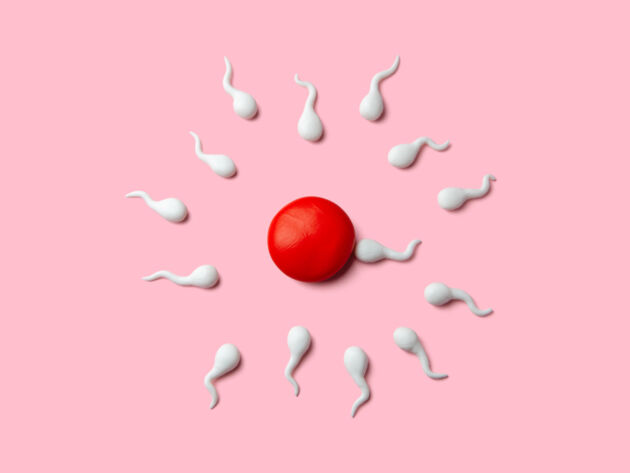After Ovulation the Egg Travels to the Uterus Through the

Written past Sarah Biddlecombe
We all know that in order to become significant, a sperm needs to fertilize an egg. Information technology sounds simple plenty, only in that location'southward more than to information technology than you might think.
If yous have unprotected sex in your fertile window, you might assume that you lot're guaranteed to get pregnant. In fact, there'south only a 10% to 33% chance of getting pregnant (depending on how shut to ovulation you do it), which shows there are a off-white few hurdles standing in the way.
If you're keen to inkling yourself upwards on all things conception, you probably want to know the details: How long does information technology actually take for sperm to reach the egg after sex? What does the journey involve? And how many sperm can you realistically expect to make information technology all the way?
To respond all these burning sex activity ed questions (and more), we dug into the research and spoke to fertility expert, reproductive endocrinologist, and Flo Medical Board member Dr. Tiffany Jones for a fascinating glimpse at what actually goes on inside after sex activity.
Take a quiz
Observe out what you tin can practice with our Wellness Assistant
How does sperm attain the egg after sex?
Starting time things first: Permit's await at where (and how far) sperm need to travel in social club to reach the egg.
Following ejaculation, sperm have to swim a mighty journeying. They need to travel from the vagina, through the cervix, into the uterus, and finally into the right uterine tube to locate the egg — no mean feat. All in all, this encompasses a distance of 15 to 18 cm and is, as Dr. Jones puts it, "a very long mode for a sperm to swim!"
How long does information technology take sperm to reach the egg?
Now that nosotros know how far they accept to travel, you're probably wondering how long information technology typically takes for sperm to swim the distance. Usually, the sperm reaches the egg within 15 to 45 minutes of ejaculation. However, the procedure could be much longer than that if you haven't ovulated yet by the time you have sex activity, considering sperm tin can alive inside a reproductive tract and await for an egg for up to five days.
While the journey to the egg is certainly long and arduous for the tiny sperm, they practise have a helping hand to swim the altitude. Inside just eight seconds of sperm entering the vagina, the pH in the upper vagina is raised, making information technology a nicer environment in which to swim. Around the aforementioned time, within a minute afterwards ejaculation, the semen becomes a gel, or coagulum. Researchers aren't yet 100% sure why this happens, but information technology has been suggested that it can help to keep the sperm virtually the opening of the cervix. Then, around 30 to sixty minutes later, the gel degrades, and the sperm can begin to swim over again. Pretty clever, right?
How many sperm reach the egg, and where does fertilization have place?
Merely a very minor fraction of ejaculated sperm really make information technology all the way to the egg. Effectually 300 million sperm are typically released during sex, but only most 200 sperm will reach the egg. This is still a pretty big number since nosotros merely demand one sperm to fertilize an egg.
Not only do these sperm take to swim a great length to reach your egg, but there are also a number of "booby traps," as Dr. Jones calls them, encountered along the way. Recall of these as your body's natural defenses to make sure only the all-time sperm accomplish your egg.
Start, sperm that accomplish the cervix will come across cervical mucus, which tin can "bind" and trap the sperm. If you're trying to conceive, don't worry. During ovulation, this mucus becomes more watery to allow more sperm to pass through.
Next, sperm that brand it through the cervix volition and then travel to either the left or correct uterine tube. This gives them a 50/50 chance of finding an egg, as nosotros ovulate in either our left or correct uterine tube each month. Dr. Jones adds that "not all of the sperm volition go in the correct management." It's estimated that only around x,000 sperm will actually enter the right tube.
To make matters even more complicated, the uterine tubes also have "very narrow" openings on the uterus side, over again reducing the number that will successfully reach their destination. Nevertheless, this is the concluding hurdle, as fertilization then typically takes place in the uterine tube.
Why doesn't pregnancy occur every time you have sex during ovulation?
And so far, the math doesn't quite seem to add up: Around 200 sperm from each ejaculation can be expected to reach the egg, yet conception simply happens between ten% and 33% of the time when unprotected sex occurs during a fertile window. So the question remains: Why doesn't pregnancy occur every time we have unprotected sex during ovulation?
In that location are a number of reasons, according to Dr. Jones. "Not every sperm is capable of fertilizing an egg due to the shape of its head or other defects it may accept that don't facilitate it in penetrating the egg'due south shell," she explains. "Also, every bit women age, the outer shell of the egg may thicken and harden, making information technology harder to fertilize."
This mismatch doesn't merely occur in the body. Dr. Jones adds, "Even in IVF [in vitro fertilization], if an egg and sperm are placed in a dish together (conventional insemination), you tin can get failed fertilization."
What happens if sperm reaches an egg that is already fertilized?
Remember those pictures of fertilized eggs yous saw in sexual practice ed class at school? More often than not, the fertilized egg was surrounded by multiple, competitive sperm that looked like they might be on the brink of inbound the egg at any moment. So the question is, can sperm enter an egg that's already been fertilized?

Quite simply, the reply is "no," says Dr. Jones. "Our eggs have a vanquish, called the zona pellucida," she explains. "Once the sperm breaks through, the shell of the egg is cemented so no other sperm can come in."
However, while a sperm can't enter an egg that's already been fertilized, it is possible for more than one sperm to enter the egg at the exact same fourth dimension. This is very rare; "double fertilization" accounts for effectually 1% of all fertilizations. Unfortunately, in this instance, in that location is usually also much genetic material for the egg to fertilize usually, and and so more often than not, it doesn't survive.
Tin can yous feel the fertilization or implantation of the egg?
No, you won't feel either fertilization or the fertilized egg embedding itself in the wall of your uterus. However, Dr. Jones does explicate that y'all might experience some low-cal bleeding or spotting when implantation occurs, so if this happens, don't worry. Still, if y'all're concerned, be certain to book a checkup with a health intendance professional.
What is implantation, and how long does it have a fertilized egg to implant?
Implantation occurs when a fertilized egg travels downwards the uterine tube to implant in the wall of the uterus. It tin have around 6 to 10 days for a fertilized egg to implant, depending on how far it has to travel. If the egg is fertilized above in the uterine tube, it will naturally take longer to motion downwards to the uterus.
Is there annihilation you can do to boost your chances of sperm fertilizing an egg?
Ideally, y'all demand to take sex no more than 5 days before ovulation in order for fertilization to occur. Y'all can boost your chances of fertilization by tracking your bike and having sex every bit shut to ovulation as possible. In fact, one study, published in the Fertility and Sterility journal in 2019, found that women were virtually likely to get pregnant (41%) by having sex the twenty-four hour period before they ovulated.
Bated from that, fertility practiced Dr. Jones says she doesn't know of anything "that would aid the sperm and egg in fertilizing naturally inside the torso." There are procedures that can exist performed in a lab if you're struggling to conceive naturally, however, such as an intracytoplasmic sperm injection. This involves sperm being physically injected into an egg but is more often than not only something that'southward suggested for couples who accept male infertility issues (like a low sperm count or depression move, for example).
How can you prevent sperm from reaching and fertilizing the egg after unprotected sex if you're trying to avoid getting pregnant?
If you lot've had unprotected sex and yous're trying to avert getting pregnant, emergency contraception such every bit the morning after pill tin either cease or delay your egg from beingness released, meaning information technology can't exist fertilized. If your egg has already been released, emergency contraception could also work to prevent fertilization or implantation from occurring.
0 Response to "After Ovulation the Egg Travels to the Uterus Through the"
Post a Comment